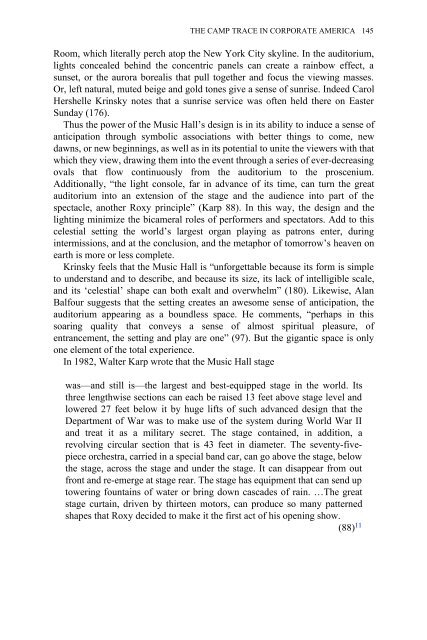Edited by Moe Meyer - Get a Free Blog
Edited by Moe Meyer - Get a Free Blog
Edited by Moe Meyer - Get a Free Blog
Create successful ePaper yourself
Turn your PDF publications into a flip-book with our unique Google optimized e-Paper software.
THE CAMP TRACE IN CORPORATE AMERICA 145<br />
Room, which literally perch atop the New York City skyline. In the auditorium,<br />
lights concealed behind the concentric panels can create a rainbow effect, a<br />
sunset, or the aurora borealis that pull together and focus the viewing masses.<br />
Or, left natural, muted beige and gold tones give a sense of sunrise. Indeed Carol<br />
Hershelle Krinsky notes that a sunrise service was often held there on Easter<br />
Sunday (176).<br />
Thus the power of the Music Hall’s design is in its ability to induce a sense of<br />
anticipation through symbolic associations with better things to come, new<br />
dawns, or new beginnings, as well as in its potential to unite the viewers with that<br />
which they view, drawing them into the event through a series of ever-decreasing<br />
ovals that flow continuously from the auditorium to the proscenium.<br />
Additionally, “the light console, far in advance of its time, can turn the great<br />
auditorium into an extension of the stage and the audience into part of the<br />
spectacle, another Roxy principle” (Karp 88). In this way, the design and the<br />
lighting minimize the bicameral roles of performers and spectators. Add to this<br />
celestial setting the world’s largest organ playing as patrons enter, during<br />
intermissions, and at the conclusion, and the metaphor of tomorrow’s heaven on<br />
earth is more or less complete.<br />
Krinsky feels that the Music Hall is “unforgettable because its form is simple<br />
to understand and to describe, and because its size, its lack of intelligible scale,<br />
and its ‘celestial’ shape can both exalt and overwhelm” (180). Likewise, Alan<br />
Balfour suggests that the setting creates an awesome sense of anticipation, the<br />
auditorium appearing as a boundless space. He comments, “perhaps in this<br />
soaring quality that conveys a sense of almost spiritual pleasure, of<br />
entrancement, the setting and play are one” (97). But the gigantic space is only<br />
one element of the total experience.<br />
In 1982, Walter Karp wrote that the Music Hall stage<br />
was—and still is—the largest and best-equipped stage in the world. Its<br />
three lengthwise sections can each be raised 13 feet above stage level and<br />
lowered 27 feet below it <strong>by</strong> huge lifts of such advanced design that the<br />
Department of War was to make use of the system during World War II<br />
and treat it as a military secret. The stage contained, in addition, a<br />
revolving circular section that is 43 feet in diameter. The seventy-fivepiece<br />
orchestra, carried in a special band car, can go above the stage, below<br />
the stage, across the stage and under the stage. It can disappear from out<br />
front and re-emerge at stage rear. The stage has equipment that can send up<br />
towering fountains of water or bring down cascades of rain. …The great<br />
stage curtain, driven <strong>by</strong> thirteen motors, can produce so many patterned<br />
shapes that Roxy decided to make it the first act of his opening show.<br />
(88) 11


